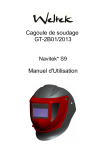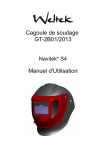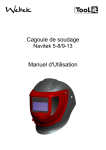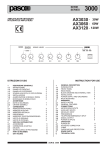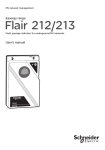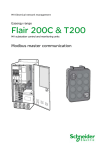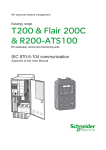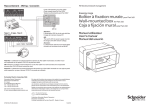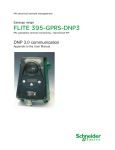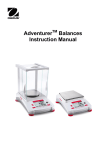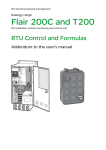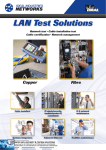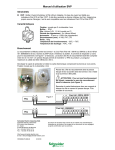Download Notice Navitek_5-8-9-13 EN
Transcript
Welding Helmet Navitek 5-8/9-13 User Instruction Manual User Manual Information manual for the Navitek 5-8/9-13 welder protective helmets complying with Par. 1.4 of Appendix ll of the EC regulations. The Navitek 5-8/9-13 welding helmets are high quality products that contribute to the comfort and safety of the welder. Navitek 5-8/9-13 welding helmets may be used only in connection with arc welding. Table 1 below shows how to choose the most suitable shade level: Table 1 Information Navitek 5-8/9-13 welding afford reliable protection for the eyes whilst electric arc welding. With the welding flip down, they offer permanent protection against UV/IR rays, heat & sparks in any state from the clear to dark. The protection shades of the Navitek 5-8/9-13 welding helmets have been chosen to avoid eye damage caused by the welding arc. Do not look directly at welding rays with unprotected eyes when the arc strikes. This can cause a painful inflammation of the cornea and irreparable damage to the lens of the eye leading to cataracts. Navitek 5-8/9-13 welding helmets allow the welder to see the point of arc strike more precisely. This leads to a real time saving. The helmet does not have to be flipped up and down during welding, both hands are kept free and because of the helmets lightweight fatigue is reduced. The helmet is available in 2 options. The helmet can be supplied with or without UVIR shade 5 side windows – the side windows giving the user a degree of side vision whilst still giving protection from the welding rays. With the welding flip raised, the inner visor offers a wide field of view and protection to the standards as listed on the rear of this manual. Range of application: The Navitek 5-8/9-13 welding helmets can be used for the following applications: Electrode, MIG, Mag, Tig They are not suitable for use with laser systems and oxy-acetylene (gas welding) applications.The welding filter must not be used for any other purpose other than welding. They should never be used as sunglasses when driving as this could lead to incorrect identification of the colour of traffic light. The welding filters operate well under extreme low lighting and very strong sunlight. Operation: Adjustment of headgear: Navitek 5-8/9-13 welding helmets are equipped with a comfortable headgear that can be adjusted in four different ways. Servicing and maintenance Navitek 5-8/9-13 welding helmets should not be dropped. Do not place heavy objects or tools (hammers etc.) on or inside the helmet so as not to damage the electro-optical filter. Always make sure that the helmet is equipped with an outside and inner lens (in front of the filter on the outside and on the inside behind the filter). These protection lenses must be replaced if damaged in any way (see overleaf). They are consumables and should checked and replaced regularly. The filter should be cleaned when changing the protection lenses. This can be done by any of the following ways: Wipe with a clean, dry piece of cloth. Clean with a piece of smooth cloth moistened with pure alcohol. Clean with a commercial disinfectant If used properly the welding filter requires no further maintenance during its lifetime. If a filter should be replaced on a Navitek 5-8/9-13 welding helmet, use exclusively certified products (DIN-CE marks). We recommend the use of Weltek welding filters in all Navitek 5-8/9-13 helmets. The filter itself contains no special or toxic products and can be disposed of in the same way as other electronic devices. Replacing the Outer Spatter Lens (6): Ensure that the helmet is always equipped with an Outside Lens (before the filter, on the outside of the helmet) and an Inner Lens (behind the filter, inside the helmet). These protection lenses must be replaced if broken, damaged or covered with welding spatter to such an extent that vision is impaired. Inner & Outer Lenses are consumables and must be replaced regularly with certified Weltek spare parts (CE marked). Before using the Navitek 5-8/9-13 helmet for the first time the protective films must be removed from the Front Spatter Lens (drawing 1), The films cannot be removed from the Front Spatter Lens with the Lens in place, Please follow the instructions below to remove the Spatter Lens. Drawing 1 Drawing 2 Inserting and removing a new protection lens : To change the outer protection (6) lens the filter must be removed by unscrewing the two retaining screws (9) from the inside of the helmet flip (2). The old protection lens can then be removed and the new lens inserted followed by the light seal cradle (7), ADF(8), inner protection lens (10) and then the ADF retaining frame (9) and finally replace the two retaining screws (see drawing 2). Inserting and removing the main clear Visor (5): To remove the main visor – simply push out from the inside, ensuring to disconnect from the lugs at the top of the visor. To replace with a new visor – locate the lugs at the top and then with some force, clip the visor into all the helmet lugs. S9 ADF: To allow the filter to switch, the sensors on the front of the filter must not be covered. The filter then switches to the dark state when the arc strikes and to the clear state when it stops. The filter switches to the light state when the welding arc stops How to set the shade: On the S9, the welding shade is selected by pushing the Weld/Grind button. 2 ranges of welding shades are available: − From Din 5 to Din 8, and − From Din 9 to Din 13, Select the welding shade by pushing the arrows on the Range button, up and down to clear or darken the welding shade. The most suitable setting can be found on the Chart in this brochure or chosen using your experience. This . setting can also be made manually during the welding process. The S9 also offers a Grinding Mode with the Weld/Grind button. The shade is then blocked in a shade DIN 4. Before using the filter we recommend the following adjustments are made: Once you have selected the Sensitivity MODE, push the UP arrow to the maximum setting. Depending upon the surrounding light the filter will switch to the dark state or will flicker (if the surrounding light is very low, the filter may not switch to the dark state). Push the DOWN arrow until the filter switches to the clear state. The filter is now set to its optimum sensitivity (According to the surrounding light conditions). Setting the delay; The clearing delay can be adjusted manually by selecting the Delay MODE and then by pushing the arrows on the Range button, up and down, to select a delay between a fast clear (0.1 sec) up to a slow clear (1.9 sec). Spare parts for GT-2B01/2013 Welding Helmets Item Part Number 1 Description Main helmet shell 2 AX3417 Flip Visor with Side Windows 3 AX1097 Longitudinal adjustment head gear 4 AX1140 Sweat band 5 AX3415 Main Visor 6 AX4000 Front Cover lens 7 AX2260 Inside Cover lens 8 AX3069 ADF Cradle 9 FI00S9 ADF 10 AX3060 Lens retainer and screws 11 Flip Visor Nuts and Bolts Items without a part number are not available as spare parts Filter Testing: Before use of the welding helmet the auto darkening filter (ADF) and helmet needs to be checked according to the following procedure: Check outer protection lens is clean and can be seen through. Ensure the the sensors are covered in any way and are clean. Once these checks have been carried out you can now test the ADF. Select the darkest setting (shade 13) and set the sensitivity to the highest setting. Now point the sensor towards a light source such as an overhead light, lamp etc. The ADF should now switch to the dark state (please note if the ADF is stored in a dark area away from light it may need to be left out in strong light for 20 minutes to absorb power, if after 20 minutes if the ADF does still not react then there is an issue with the sensor). Once the filter is in the dark state you can check the shade variation is functioning correctly, simply adjust the shade. By doing this, the shade should get lighter. If the shade does not appear to alter then you have an issue with the shade variation. To test the delay function set the delay to the maximum setting. Now move the filter sensor away from the light source it should take 1 second to return to the light state, now alter the delay setting to the minimum and repeat the process, the time taken to return to the clear state should be 0.1 second. If the ADF does not react in this way then there is an issue with the delay function. Testing the sensitivity. Set the sensitivity to minimum setting now point the ADF at the light source you used to test the other functions (if filter switches to dark state move away until the filter returns to clear state) slowly reduce the sensitivity until the filter switches to dark state (if it does not then move closer to the light until it reacts). If the ADF does not react then there is an issue with the light sensors. If any of the functions fail during test or in use then please do not use the ADF and contact your local distributor. Warning The auto-darkening filters fitted in the Navitek 5-8/9-13 helmets are not waterproof and will not work properly if they have been in contact with water. Welding helmets and filters only resist a certain amount of heat. Please do not place them near naked flames or hot work areas etc. Operating temperature of electronic filter minus 5ºC to plus 55ºC. Materials that may get in contact with the wearers skin could cause Allergic reactions to susceptible individuals Certification and Control labels The S9 welding filters are tested for eye protection by the following notified body: ECS GmbH Obere Bahnstrasse 74, 73431 Aalen Germany, notified body 1883, that provides approval and continual quality system under the control of the European Commission, the German Ministry for Work and the Central Office of the Provinces. European Conformity mark. This confirms that the product fulfills the requirements of the Directive 89/686/EWG Notified Body ECS GmbH Registration Number 1883 Obere Bahnstrasse 74 73431 Aalen GERMANY ADF Marking Explaination: CE 4/5-8/9-13 W2B 1/1/1/2/379 4 - light state scale number 5- lightest dark state scale number 13 darkest state scale number W2B - Manufactures identification 1 - Optical class 1 - Diffusion of light class 1 - variation in luminous transmittance class 2 – Angle of Dependence classification 379 - Number of the standard WELTEK ZI DES BATTERSES 01700 BEYNOST FRANCE TEL 0033 437855427 WELTEK operates a policy of continuous improvement. We therefore reserve the right to make changes and improvements to any of our products without notice






